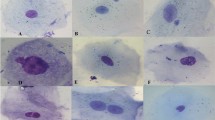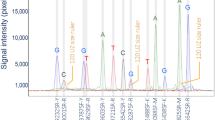Abstract
More than 100,000 dog attacks occur each year in Australia and many go unsolved. Dog attacks are not only a cause of human injury but may also involve injury and death to family pets, prized livestock and wildlife. Canine biological evidence can often be left behind on a victim or at the scene of an attack. Our laboratory provides canine DNA profiling for forensic investigations, utilising an in-house panel of 11 canine-specific autosomal short tandem repeat markers previously validated for use in casework. Case studies will be presented that outline methods for sampling of suspected canine biological evidence, profiling of canine DNA, statistical analysis, case outcomes and challenges for investigators.



Similar content being viewed by others
References
Australian Companion Animal Council. Dogs in society position paper—Review of dog bite prevention programs in Australia, 2007.
DeNise S, Johnston E, Halverston J, Marshall K, Rosenfield D, McKenna S, et al. Power of exclusion for parentage verification and probability of match for identity in American kennel club breeds using 17 canine microsatellite markers. Anim Genet. 2003;35:14–7.
Francisco LV, Langston AA, Mellersh CS, Neal CL, Ostrander EA. A class of highly polymorphic tetranucleotide repeats for canine genetic mapping. Mamm Genome. 1996;7:359–62.
Zajc I, Mellersh CS, Sampson J. Variability of canine microsatellites within and between different dog breeds. Mamm Genome. 1997;8(3):182–5.
Morera L, Barba CJ, Garrido JJ, Barbancho M, de Andres DF. Genetic variation detected by microsatellites in five Spanish dog breeds. J Hered. 1999;90(6):654–6.
Irion DN, Schaffer AL, Famula TR, Eggleston ML, Hughes SS, Pedersen NC. Analysis of genetic variation in 28 dog breed populations with 100 microsatellite markers. J Hered. 2003;94(1):81–7.
Halverston J, Basten C. A PCR Multiplex and Database for Forensic DNA Identification of Dogs. J Forensic Sci. 2005;50(2):352–63.
Blejwas K, Williams C, Shin G, McCullough D, Jaeger M. Salivary DNA evidence convicts male coyotes of killing sheep. J Wildl Manag. 2006;70:1087–93.
Sundqvist A, Ellegren H, Vila C. Wolf or dog? Genetic identification of predators from saliva collected around bite wounds on prey. Conserv Genet. 2008;9:1275–9.
Halverston J, Dvorak J, Stevenson T. Microsatellite sequences for canine genotyping. US Patent 05874217, 1995.
Taberlet P, Griffin S, Goosens B, Questiau S, Manceau V, Escaravage N, et al. Reliable genotyping of samples with very low DNA quantities using PCR. Nucleic Acids Res. 1996;24(16):3189–94.
Tereba A. Tools for analysis of population statistics. Profiles in DNA 1999;2(3).
Lewis PO, Zaykin D. Genetic data analysis: portable version 1.1 for Linux, 1996 (Software available at http://lewis.eeb.uconn.edu/lewishome/software.html).
Balding DJ, Nicholls RA. DNA profile match probability calculation: how to allow for population stratification, relatedness, database selection and single bands. Forensic Sci Int. 1994;64:125–40.
Chakraborty R, Srinivasan MR, Daiger SP. Evaluation of standard error and confidence interval of estimated multilocus genotype probabilities, and their implications in DNA forensics. Am J Hum Genet. 1993;52:60–70.
Kanthaswamy S, Tom BK, Mattila A, Johnston E, Dayton M, Kinaga EricksonBJA, et al. Canine population data generated from a multiplex STR kit for use in forensic casework J. Forensic Sci. 2009;54(4):829–40.
Akane A, Matsubara K, Nakamura H, Takahashi S, Kimura K. Identification of the heme compound copurified with deoxyribonucleic acid (DNA) from bloodstains, a major inhibitor of polymerase chain reaction (PCR) amplification. J Forensic Sci. 2004;39:362–72.
Vandenberg N, van Oorschot RAH. The use of polilight in the detection of seminal fluid, saliva and bloodstains and comparison to conventional chemical based screening tests. J Forensic Sci. 2006;51:361–70.
Brauner P, Reshef A, Gorski A. DNA profiling of trace evidence—mitigating evidence in a dog biting case. J Forensic Sci. 2001;46(5):1232–4.
Mitchell BD, Banks PB. Do wild dogs exclude foxes? evidence for competition from dietary and spatial overlaps. Austral Ecol. 2005;30:581–91.
NSW Scientific Committee—final determination. Predation and Hybridisation by Feral Dogs (Canis lupus familiaris)—key threatening process listing, July 2009. www.environment.nsw.gov.au/determinations/feraldogsFD.htm.
Author information
Authors and Affiliations
Corresponding author
Rights and permissions
About this article
Cite this article
Clarke, M., Vandenberg, N. Dog attack: the application of canine DNA profiling in forensic casework. Forensic Sci Med Pathol 6, 151–157 (2010). https://doi.org/10.1007/s12024-009-9114-8
Accepted:
Published:
Issue Date:
DOI: https://doi.org/10.1007/s12024-009-9114-8




